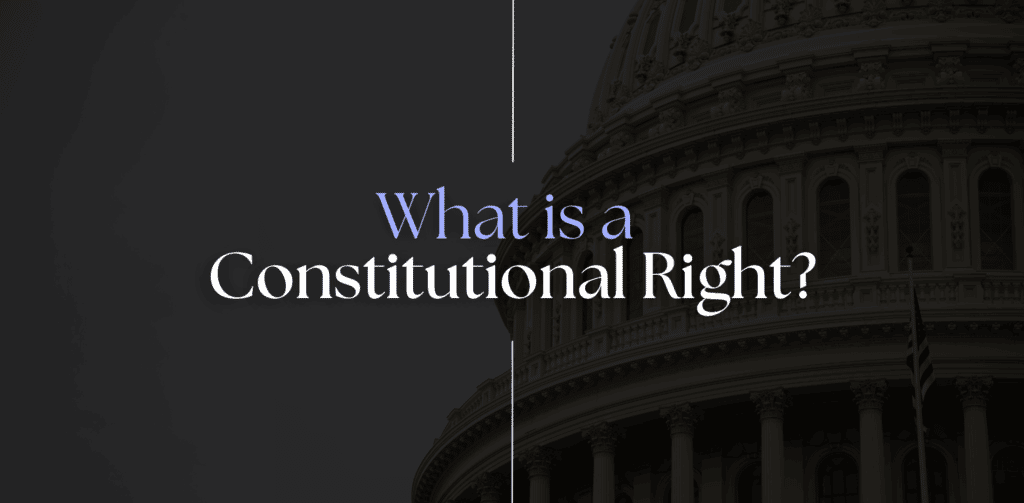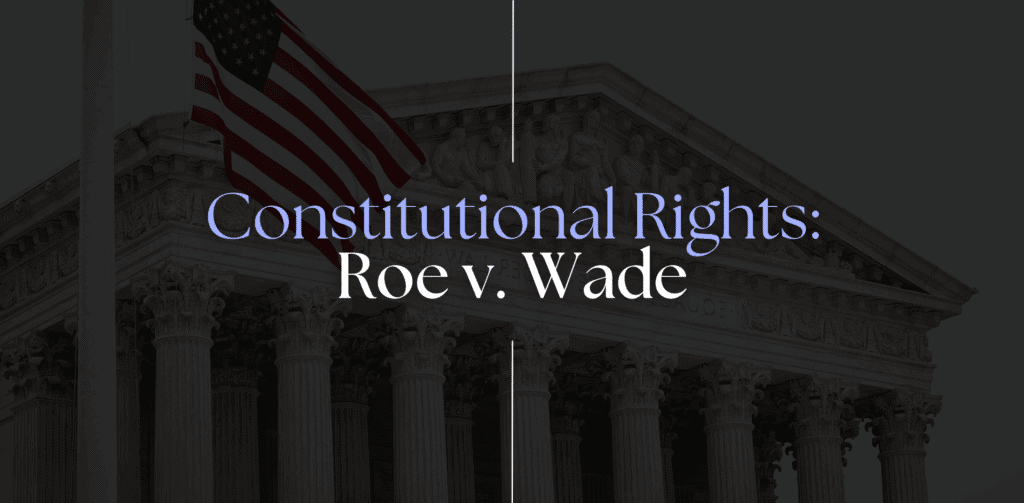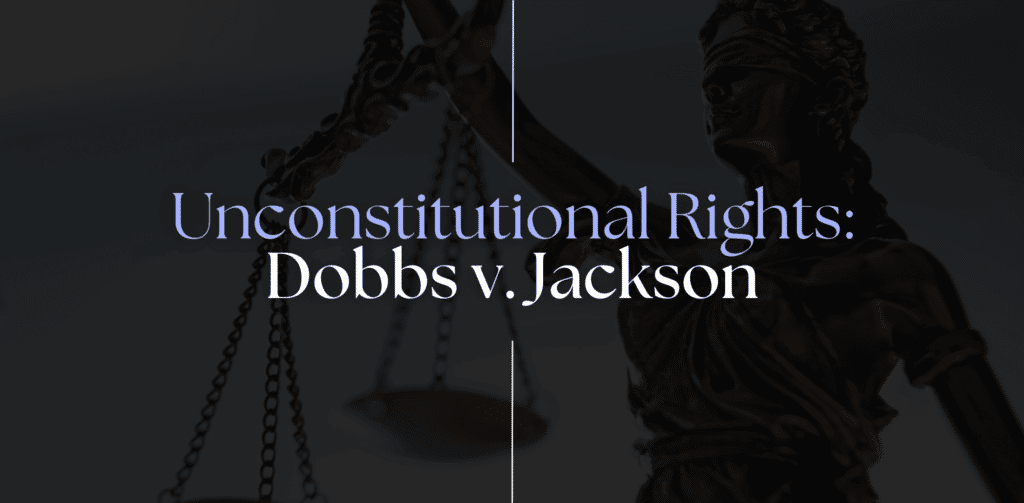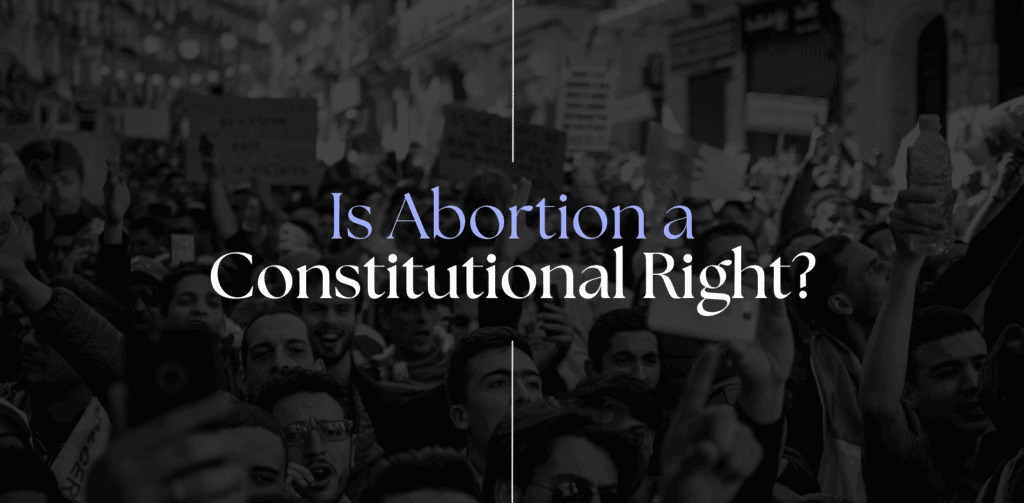Abortion is a constitutional right.
Life in the womb is a constitutional right.
You’ve probably heard both. Somehow, the U.S. holds wildly different beliefs among its citizens: either a woman’s right trumps a baby or a baby’s rights trump a woman’s right. Both pro-life and pro-choice sides agree that the Constitution should have the final say. But since it doesn’t explicitly mention abortion, different interpretations of the Constitution are in all abortion rulings.
Roe v. Wade – the Supreme Court case that legalized abortion nationwide – was ruled on, reinforced (through Casey v. Planned Parenthood) and overruled (through Dobbs v. Jackson Women’s Health). The rulings came from the same Supreme Court with the same goal to uphold the Constitution. The only difference was who was seated on the Court. And because abortion is not mentioned, bias informs some of those Court decisions. Some abortion rulings involved more reading between the lines than they acknowledged. We can compare their reasoning to constitutional accuracy by looking at each decision.

First, what is a constitutional right? Cornell University describes it as:
We consider the Constitution as the supreme law of the land. Consequently, all laws that the state or federal government makes contradicting it are therefore invalid.

Roe v. Wade is a legal case brought to the Supreme Court by Norma McCorvey (under the legal pseudonym “Jane Roe”) against the state. She was unexpectedly pregnant with her third child in 1969 and sought an abortion. But, she lived in a state that had recently implemented an abortion ban. She claimed that abortion bans were unconstitutional; that she was denied a basic human right. Ultimately, the Court sided with McCorvey and declared abortion a nationally protected right on January 22, 1973.
So, why is abortion a constitutional right in the Court’s eyes?
In the 7-2 landmark decision, the majority opinion (by Justice Harry Blackmun) states abortion is an indirect liberty. In the Court’s opinion, the Constitution implies a “right to privacy” in the Due Process Clause of the 14th Amendment and informs it through the First, Third, Fourth, Fifth and Ninth Amendments.
“Congress shall make no law respecting an establishment of religion, or prohibiting the free exercise thereof; or abridging the freedom of speech, or of the press; or the right of the people peaceably to assemble, and to petition the Government for a redress of grievances.” – First Amendment of the United States Constitution
“No Soldier shall, in time of peace be quartered in any house, without the consent of the Owner, nor in time of war, but in a manner to be prescribed by law.” – Third Amendment of the United States Constitution
“The right of the people to be secure in their persons, houses, papers, and effects, against unreasonable searches and seizures, shall not be violated, and no Warrants shall issue, but upon probable cause, supported by Oath or affirmation, and particularly describing the place to be searched, and the persons or things to be seized.” – Fourth Amendment of the United States Constitution
“No person shall be held to answer for a capital, or otherwise infamous crime, unless on a presentment or indictment of a Grand Jury, except in cases arising in the land or naval forces, or in the Militia, when in actual service in time of War or public danger; nor shall any person be subject for the same offence to be twice put in jeopardy of life or limb; nor shall be compelled in any criminal case to be a witness against himself, nor be deprived of life, liberty, or property, without due process of law; nor shall private property be taken for public use, without just compensation.” – Fifth Amendment of the United States Constitution
“The enumeration in the Constitution, of certain rights, shall not be construed to deny or disparage others retained by the people.” – Ninth Amendment of the United States Constitution
“All persons born or naturalized in the United States, and subject to the jurisdiction thereof, are citizens of the United States and of the State wherein they reside. No State shall make or enforce any law which shall abridge the privileges or immunities of citizens of the United States; nor shall any State deprive any person of life, liberty, or property, without due process of law; nor deny to any person within its jurisdiction the equal protection of the laws.” – Section 1 of the Fourteenth Amendment of the United States
So, when Roe was ultimately overturned in 2022, Justice Alito wrote in the Court’s majority opinion that Roe “was remarkably loose in its treatment of the constitutional text. It held that the abortion right, which is not mentioned in the Constitution, is part of the right to privacy, which is also not mentioned. And that privacy right, Roe observed, had been found to spring from no fewer than five different constitutional provisions—the First, Fourth, Fifth, Ninth, and Fourteenth Amendments.”
But, acknowledging that it isn’t in the Constitution at all, Roe’s majority claims the right to privacy is “broad enough to encompass a woman’s decision whether or not to terminate her pregnancy.”
Setting that standard comes with consequences, though. One could argue that reading between the lines also allows just about anything not done in public. Things like child abuse, illicit drug use and nonconsensual pornography are private acts – are they protected too? Where is the line drawn when broadening the Constitution?

For years, Roe was praised by abortion advocates and rejected by pro-life groups. However, everything changed on June 24, 2022, when the historic decision ended through Dobbs v. Jackson Women’s Health Organization. The case concerned the constitutionality of a 2018 Mississippi state law that banned most abortions after 15 weeks of pregnancy. The law was based on an Alliance Defending Freedom model, intending to provoke a legal battle that would ultimately reexamine the constitutionality of abortion rights. In a 6-3 decision, the majority stated that Roe must be overruled due to the Court being “egregiously wrong” and arguing points that were “exceptionally weak” and so “damaging” that they amounted to “an abuse of judicial authority.” They argued that the government wrongly overreached in its previous decisions. They then returned the decision to elected state representatives and, in turn, the people.
Though not a constitutional tenet, the United States’ legal system typically follows precedent. Precedence (through stare decisis) lays the groundwork for stability and uniformity among courts. A court can overlook precedence. However, the substantial evidence needed to do so makes it rare.
So, when the Supreme Court decided to overturn Roe v. Wade and Casey v. Planned Parenthood, the Justices had a heavy burden to prove beyond doubt that abortion isn’t a constitutional right. Additionally, abortion advocates pressured the Court, as they saw Roe as immutable and permanent law: Planned Parenthood’s president, Gloria Feldt, said that Roe “guaranteed the basic human right [for women] to make their own childbearing choices – a right as intrinsic as the right to breathe and to walk, to work and to think, to speak our truths, to thrive, to learn and to love.”
The majority opinion was written by Justice Alito and joined by Justices Thomas, Gorsuch, Kavanaugh and Barrett. In it, Justice Alito writes that “stare decisis, the doctrine on which Casey’s controlling opinion was based, does not compel unending adherence to Roe’s abuse of judicial authority.” He goes on to say that “the Constitution makes no reference to abortion, and no such right is implicitly protected by any constitutional provision, including the one on which the defenders of Roe and Casey now chiefly rely—the Due Process Clause of the Fourteenth Amendment.” Then, the opinion discusses abortion’s divergence from other Court rulings and the overextending authority of Roe:
Moreover, Justice Alito cites another constitutional right not present in Roe. “It is time to heed the Constitution and return the issue of abortion to the people’s elected representatives. The permissibility of abortion, and the limitations, upon it, are to be resolved like most important questions in our democracy: by citizens trying to persuade one another and then voting.”

So, is abortion a constitutional right? No. Far from it. The legal rulings that previously declared abortion as a right lacked constitutionality. The majority opinions in Roe and Casey even acknowledge that the Constitution doesn’t protect abortion as a “fundamental right.” With the recent Dobbs ruling, the Supreme Court ruled solely on what is written in the Constitution instead of loosely implied – including the right to life.
The country is now closer to the Constitution’s intent than ever before. By protecting men and women’s safety both in and out of the womb, we are returning to our country’s equality-granting, fundamental, life-affirming roots.
The post Is Abortion A Constitutional Right? appeared first on Focus on the Family.
Continue reading...
Life in the womb is a constitutional right.
You’ve probably heard both. Somehow, the U.S. holds wildly different beliefs among its citizens: either a woman’s right trumps a baby or a baby’s rights trump a woman’s right. Both pro-life and pro-choice sides agree that the Constitution should have the final say. But since it doesn’t explicitly mention abortion, different interpretations of the Constitution are in all abortion rulings.
Roe v. Wade – the Supreme Court case that legalized abortion nationwide – was ruled on, reinforced (through Casey v. Planned Parenthood) and overruled (through Dobbs v. Jackson Women’s Health). The rulings came from the same Supreme Court with the same goal to uphold the Constitution. The only difference was who was seated on the Court. And because abortion is not mentioned, bias informs some of those Court decisions. Some abortion rulings involved more reading between the lines than they acknowledged. We can compare their reasoning to constitutional accuracy by looking at each decision.
What Is a Constitutional Right?

First, what is a constitutional right? Cornell University describes it as:
Constitutional rights are the protections and liberties guaranteed to the people by the U.S. Constitution. Many of these rights are outlined in the Bill of Rights; such as the right to free speech in the First Amendment, and the right to a speedy and public trial in the Sixth Amendment. Even though these rights are expressly stated, their scope and proper implementation remains the subject of debate.
Cornell University
We consider the Constitution as the supreme law of the land. Consequently, all laws that the state or federal government makes contradicting it are therefore invalid.
Related Watching:
Related Reading:
- Should Abortion Be Legal?
- Is Abortion Murder?
- Abortion: The Issue
- Pro-Life Vs. Pro Choice: What Do They Mean?
- Abortion Rights and Bans in a Post-Roe World
Constitutional Rights Claimed in Roe

Roe v. Wade is a legal case brought to the Supreme Court by Norma McCorvey (under the legal pseudonym “Jane Roe”) against the state. She was unexpectedly pregnant with her third child in 1969 and sought an abortion. But, she lived in a state that had recently implemented an abortion ban. She claimed that abortion bans were unconstitutional; that she was denied a basic human right. Ultimately, the Court sided with McCorvey and declared abortion a nationally protected right on January 22, 1973.
How Is Abortion a Constitutional Right?
So, why is abortion a constitutional right in the Court’s eyes?
In the 7-2 landmark decision, the majority opinion (by Justice Harry Blackmun) states abortion is an indirect liberty. In the Court’s opinion, the Constitution implies a “right to privacy” in the Due Process Clause of the 14th Amendment and informs it through the First, Third, Fourth, Fifth and Ninth Amendments.
Amendments Claimed to Support Abortion
I
“Congress shall make no law respecting an establishment of religion, or prohibiting the free exercise thereof; or abridging the freedom of speech, or of the press; or the right of the people peaceably to assemble, and to petition the Government for a redress of grievances.” – First Amendment of the United States Constitution
III
“No Soldier shall, in time of peace be quartered in any house, without the consent of the Owner, nor in time of war, but in a manner to be prescribed by law.” – Third Amendment of the United States Constitution
IV
“The right of the people to be secure in their persons, houses, papers, and effects, against unreasonable searches and seizures, shall not be violated, and no Warrants shall issue, but upon probable cause, supported by Oath or affirmation, and particularly describing the place to be searched, and the persons or things to be seized.” – Fourth Amendment of the United States Constitution
V
“No person shall be held to answer for a capital, or otherwise infamous crime, unless on a presentment or indictment of a Grand Jury, except in cases arising in the land or naval forces, or in the Militia, when in actual service in time of War or public danger; nor shall any person be subject for the same offence to be twice put in jeopardy of life or limb; nor shall be compelled in any criminal case to be a witness against himself, nor be deprived of life, liberty, or property, without due process of law; nor shall private property be taken for public use, without just compensation.” – Fifth Amendment of the United States Constitution
IX
“The enumeration in the Constitution, of certain rights, shall not be construed to deny or disparage others retained by the people.” – Ninth Amendment of the United States Constitution
XIV
“All persons born or naturalized in the United States, and subject to the jurisdiction thereof, are citizens of the United States and of the State wherein they reside. No State shall make or enforce any law which shall abridge the privileges or immunities of citizens of the United States; nor shall any State deprive any person of life, liberty, or property, without due process of law; nor deny to any person within its jurisdiction the equal protection of the laws.” – Section 1 of the Fourteenth Amendment of the United States
Pro-Life Response to Roe
So, when Roe was ultimately overturned in 2022, Justice Alito wrote in the Court’s majority opinion that Roe “was remarkably loose in its treatment of the constitutional text. It held that the abortion right, which is not mentioned in the Constitution, is part of the right to privacy, which is also not mentioned. And that privacy right, Roe observed, had been found to spring from no fewer than five different constitutional provisions—the First, Fourth, Fifth, Ninth, and Fourteenth Amendments.”
But, acknowledging that it isn’t in the Constitution at all, Roe’s majority claims the right to privacy is “broad enough to encompass a woman’s decision whether or not to terminate her pregnancy.”
Setting that standard comes with consequences, though. One could argue that reading between the lines also allows just about anything not done in public. Things like child abuse, illicit drug use and nonconsensual pornography are private acts – are they protected too? Where is the line drawn when broadening the Constitution?
Related Reading:
- Abortion Pros and Cons: 5 Pro-Life Arguments
- The History of Abortion
- Overturning Roe v. Wade: Laws That Hurt Women
- I Watched A Real Abortion Procedure Video
Related Watching:
Constitutional Rights Claimed in Dobbs

For years, Roe was praised by abortion advocates and rejected by pro-life groups. However, everything changed on June 24, 2022, when the historic decision ended through Dobbs v. Jackson Women’s Health Organization. The case concerned the constitutionality of a 2018 Mississippi state law that banned most abortions after 15 weeks of pregnancy. The law was based on an Alliance Defending Freedom model, intending to provoke a legal battle that would ultimately reexamine the constitutionality of abortion rights. In a 6-3 decision, the majority stated that Roe must be overruled due to the Court being “egregiously wrong” and arguing points that were “exceptionally weak” and so “damaging” that they amounted to “an abuse of judicial authority.” They argued that the government wrongly overreached in its previous decisions. They then returned the decision to elected state representatives and, in turn, the people.
Reversing Precedent
Though not a constitutional tenet, the United States’ legal system typically follows precedent. Precedence (through stare decisis) lays the groundwork for stability and uniformity among courts. A court can overlook precedence. However, the substantial evidence needed to do so makes it rare.
The Supreme Court applies the doctrine of stare decisis by following the rules of its prior decisions unless there is a ‘special justification’ — or, at least, ‘strong grounds’ — to overrule precedent.
Congressional Research Service 2018 Report
So, when the Supreme Court decided to overturn Roe v. Wade and Casey v. Planned Parenthood, the Justices had a heavy burden to prove beyond doubt that abortion isn’t a constitutional right. Additionally, abortion advocates pressured the Court, as they saw Roe as immutable and permanent law: Planned Parenthood’s president, Gloria Feldt, said that Roe “guaranteed the basic human right [for women] to make their own childbearing choices – a right as intrinsic as the right to breathe and to walk, to work and to think, to speak our truths, to thrive, to learn and to love.”
How Is Abortion Not a Constitutional Right?
The majority opinion was written by Justice Alito and joined by Justices Thomas, Gorsuch, Kavanaugh and Barrett. In it, Justice Alito writes that “stare decisis, the doctrine on which Casey’s controlling opinion was based, does not compel unending adherence to Roe’s abuse of judicial authority.” He goes on to say that “the Constitution makes no reference to abortion, and no such right is implicitly protected by any constitutional provision, including the one on which the defenders of Roe and Casey now chiefly rely—the Due Process Clause of the Fourteenth Amendment.” Then, the opinion discusses abortion’s divergence from other Court rulings and the overextending authority of Roe:
The abortion right is also critically different from any other right that this Court has held to fall within the Fourteenth Amendment’s protection of ‘liberty.’ Roe’s defenders characterize the abortion right as similar to the rights recognized in past decisions involving matters such as intimate sexual relations, contraception, and marriage, but abortion is fundamentally different, as both Roe and Casey acknowledged, because it destroys what those decisions called ‘fetal life’ and what the law now before us describes as an ‘unborn' human being.
Majority Opinion, Dobbs v. Jackson Women's Health Organization
More Rights Instead of Less
Moreover, Justice Alito cites another constitutional right not present in Roe. “It is time to heed the Constitution and return the issue of abortion to the people’s elected representatives. The permissibility of abortion, and the limitations, upon it, are to be resolved like most important questions in our democracy: by citizens trying to persuade one another and then voting.”
Related Watching:
Related Reading:
- Reproductive Justice Doesn’t Include Abortion
- What Are Human Rights?
- Bodily Autonomy and “My Body My Choice”
- Are Late-Term Abortions Still A Thing?
- Abortion Complications
Is Abortion a Constitutional Right?

So, is abortion a constitutional right? No. Far from it. The legal rulings that previously declared abortion as a right lacked constitutionality. The majority opinions in Roe and Casey even acknowledge that the Constitution doesn’t protect abortion as a “fundamental right.” With the recent Dobbs ruling, the Supreme Court ruled solely on what is written in the Constitution instead of loosely implied – including the right to life.
The country is now closer to the Constitution’s intent than ever before. By protecting men and women’s safety both in and out of the womb, we are returning to our country’s equality-granting, fundamental, life-affirming roots.
The post Is Abortion A Constitutional Right? appeared first on Focus on the Family.
Continue reading...





